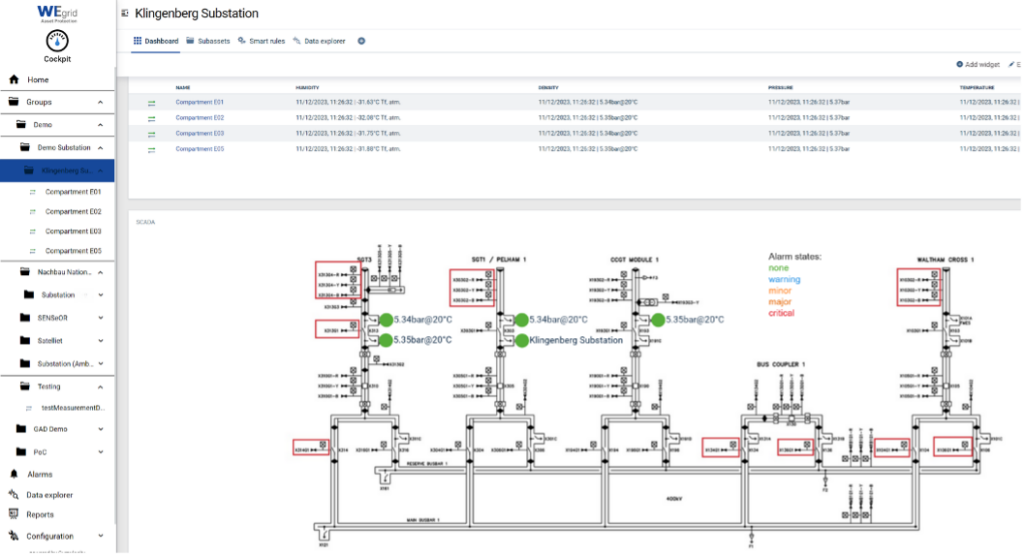Gas-insulated switchgear plays a key role when the available installation space needs to be used efficiently. Monitoring and maintaining them is a challenge, especially preventing gas leaks of the climate-damaging sulphur hexafluoride (SF₆), which impair the critical functionality of the facilities. WIKA Alexander Wiegand SE & Co. KG has innovative solutions for IoT-based monitoring with state-of-the-art sensor technology.
The challenge: Early detection of leaks in gas-insulated switchgear
Gas-insulated switchgear is mainly used in medium and high-voltage plants. These are completely gas-tight encapsulated switchgear units that are flooded with an inert gas to insulate the electrical conductors. Sulphur hexafluoride is normally used as the insulating gas. This gas has five times the density of air, is colorless and odorless, non-toxic and inert. The dielectric strength to electric current is about three times higher than that of air.
SF₆ reduces the risk of sparks and arcing during switching operations. This means that gas-insulated switchgear is much more compact than conventional outdoor switchgear and can also be used where space is limited, for example in urban environments, wind turbines, hydroelectric power stations, industrial plants or on offshore platforms.
Switchgear typically has a service life of 20 to 50 years, with gas-related failures increasing significantly 15 to 25 years after installation. Monitoring is therefore crucial starting in the second half of the system’s service life at the latest. SF₆ is also the most potent greenhouse gas known, with around 22,800 times the climate impact of CO₂. One kilo of SF₆ therefore corresponds to 22.8 tons of CO₂. Therefore, maintenance is also very time-consuming, as SF₆ must be pumped out and recovered.
The operators of such switchgear therefore have a high demand for permanent monitoring of their systems in order to detect leaks at all times and only carry out maintenance when it is actually necessary.
The solution: An IoT-based monitoring solution with modern sensor technology
WIKA Alexander Wiegand SE & Co. KG is a German, internationally active family business that primarily manufactures pressure and temperature measurement technology. The company has developed a complete solution for system monitoring for operators of gas-insulated switchgear. This includes the necessary measurement technology with sensors, monitoring and forecasting with software and service.
Sensor Technology
For monitoring purposes, the manufacturer equips the plants with sensors for measuring gas density and humidity. This means that both leaks and contamination of the gas are detected at an early stage. The sensors in indoor facilities are connected to the cloud or a local server via cables and an edge gateway to the internet.
Wireless technology is also used for large outdoor plants, with which the sensor data is transmitted to the Internet via the energy-saving LoRaWAN wireless network and a corresponding gateway. In this way, distances of 10 kilometers and more can be bridged. When monitoring SF₆, the size of the data packets and the frequency of transmission are not critical, meaning that battery-powered low-power technology is completely sufficient here.

The Platform
All the information supplied by the sensors is collected in a secure cloud, processed using algorithms and made available to users on a dashboard. Both stationary and mobile devices can access this platform.
Customer and system-specific limit values can be set in the platform, which trigger an alarm if, for example, the humidity is too high, the temperature fluctuates significantly or the gas pressure suddenly drops. Moreover, the WIKA software is capable of defining an expected range for the future through the evaluation of historical data using intelligent algorithms. This allows forecasts to be made and warnings to be sent at an early stage, even before the actual limit values are reached.

The monitoring system from WIKA is set up within a few hours and then configured and ready for operation after just a few minutes.
The added business value comes from data analyses that reduce maintenance and service cycles. Customers can query the data via an API and integrate it into their own cloud platform. WIKA cooperates with partners to tackle industry-specific topics such as diagnostics, compliance and documentation.

The result: Increased efficiency and reduced costs with intelligent IoT monitoring
Efficiency and safety are key elements in the operation of switchgear. IoT-based monitoring solutions aim to improve both. By utilizing modern sensor technology for condition monitoring and automating the documentation of obtained values, operators reduce the need for technician inspections, resulting in lower maintenance costs.
The use of sulphur hexafluoride in gas-insulated switchgear poses challenges, as it is considered a potent greenhouse gas. The leakage of SF₆ can be reduced by increasing maintenance efforts and improving plant safety. This can not only help to reduce potential fines for operators due to environmental regulations, but also actively supports environmental protection.
In addition, remote monitoring also enables predictive maintenance to prevent damage to the machine. The software’s predictive algorithms detect potential problems before they occur, increasing safety and reducing downtime and costs.







